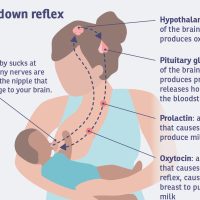Breastfeeding and Maternal Smoking: Key Considerations
A mother who is unable to quit smoking should continue breastfeeding. Breastfeeding offers vital immune protections that help infants combat illnesses and may mitigate certain harmful effects of cigarette smoke. For instance, studies indicate that breastfeeding can reduce the negative impact of smoke exposure on a baby’s lung health. While abstaining from smoking is ideal for nursing mothers, breastfeeding remains a safer choice compared to formula feeding if smoking cessation is not feasible.
The health risks for both mother and child increase with the number of cigarettes smoked daily. If quitting entirely is not an option, reducing cigarette consumption can lower these risks. Even partial reduction in smoking frequency may provide some protective benefits for the infant.
Health Impacts of Cigarette Smoke Exposure on Infants and Children
Infants and children exposed to cigarette smoke face significantly higher risks of respiratory and systemic illnesses, including pneumonia, asthma, ear infections, bronchitis, sinus inflammation, and croup. Additionally, colic is more prevalent among babies with smoking parents or breastfeeding mothers who smoke. Research suggests nicotine transfer through breast milk and environmental smoke exposure may irritate infants, worsening colic symptoms. Smoking mothers may also struggle to manage colicky babies due to reduced prolactin levels, which are critical for stress regulation.
Heavy maternal smoking during breastfeeding can lead to gastrointestinal distress in infants, such as nausea, vomiting, abdominal cramps, and diarrhea. Tragically, infants exposed to parental smoke have a sevenfold increased risk of sudden infant death syndrome (SIDS). These children also require medical care two to three times more frequently, primarily for respiratory infections or allergy-related conditions.
Long-term health consequences include reduced levels of HDL (“good” cholesterol) in children, heightening their susceptibility to coronary artery disease later in life. Behavioral modeling also plays a role: children raised in smoking households are more likely to adopt the habit themselves. A recent study further revealed that dual parental smoking doubles a child’s lifetime risk of developing lung cancer.
Impacts of Smoking on Breastfeeding Dynamics and Infant Health
Smoking during breastfeeding is associated with several adverse effects. Research indicates that heavy smokers often wean their infants earlier than non-smoking mothers. Additionally, smoking may reduce milk supply and interfere with the milk let-down reflex, potentially due to lower prolactin levels—a hormone essential for milk synthesis. A 2004 study highlighted that smoking mothers in regions with mild to moderate iodine deficiency have lower iodine levels in their breastmilk, which is critical for infant thyroid function. The authors recommended iodine supplementation for breastfeeding mothers who smoke.
While smoking has been linked to lactation challenges, some evidence suggests these issues may stem from suboptimal breastfeeding practices rather than direct physiological effects. Dr. Lisa Amir’s 2001 review noted that although smoking correlates with shorter breastfeeding durations, the biological mechanisms behind this remain inconclusive. For instance, smoking during pregnancy can impair a baby’s sucking ability in early weeks, indirectly affecting milk production if feeding frequency or latch quality is compromised.
To mitigate risks, mothers are advised to smoke outdoors, change clothes before handling the baby, and time smoking sessions to minimize nicotine transfer (e.g., breastfeeding immediately before smoking and waiting 2–3 hours afterward). Even with these challenges, breastfeeding remains preferable to formula feeding for smoking mothers, as it lowers infants’ risks of colic, respiratory infections, and sudden infant death syndrome (SIDS).
Minimizing Infant Health Risks When Maternal Smoking Continues
The most effective approach to protect your baby is to quit smoking entirely. For mothers unable to cease smoking, reducing daily cigarette consumption can lower risks, particularly when smoking fewer than 20 cigarettes per day. Avoid smoking immediately before or during breastfeeding, as nicotine exposure during nursing can inhibit milk let-down reflexes and compromise infant safety.
To reduce nicotine transfer through breast milk, smoke immediately after breastfeeding and allow sufficient time between smoking and the next feeding session. Research indicates it takes approximately 95 minutes for half the nicotine dose to metabolize.
Environmental precautions are critical:
- Never smoke indoors near the baby. Opt for outdoor smoking away from children.
- Change clothing after smoking to minimize thirdhand smoke residue on fabrics.
- Prohibit others from smoking near the infant, as secondhand smoke increases risks of respiratory infections and sudden infant death syndrome (SIDS).
While breastfeeding remains preferable to formula feeding for smoking mothers due to its immune benefits, combining these strategies can mitigate nicotine’s impact on milk quality and infant health.




